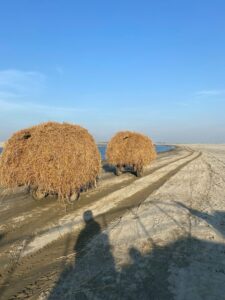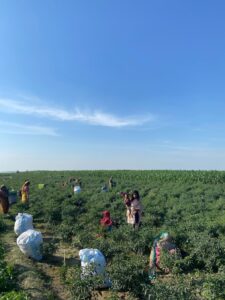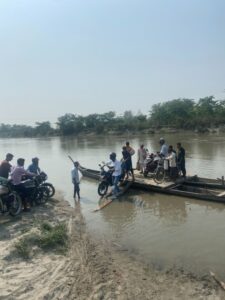
By the Brahmaputra ( Vol: 64, April – June 2024)
International Nurses Day
Nurses Day is a special occasion dedicated to honoring and celebrating the contributions of nurses worldwide. Observed annually on May 12, the birth anniversary of Florence Nightingale, this day was established by the International Council of Nurses and has been officially recognized since 1974. The nurses serving the 15 Boat Clinic units, like their counterparts around the globe, work with dedication and sincerity. The team members express their gratitude to these nurses who work tirelessly, passionately, and selflessly.
Radio Brahmaputra: Livelihood Enhancement Training for Women
A five-day livelihood enhancement training program for women from various tea gardens and villages in Dibrugarh commenced on May 15, 2024, at the Radio Brahmaputra premises. The training program is organized by Aide et Action in collaboration with ASRLM, Brahmaputra Foundation for SR&LP, and Radio Brahmaputra.
Aide et Action International, a nonprofit organization in India, provides support to local actors for implementing diverse programs related to early childhood care and education, livelihood for excluded youth from marginalized sections, health, environment, social cohesion, and the inclusion of the girl child.
With initial support from UNICEF, C-NES launched the Brahmaputra Community Radio Station 90.4FM (BCRS), popularly known as “Radio Brahmaputra,” the first grassroots community radio station in Northeast India, in 2009. The station began its formal broadcast in July 2015. Based in Maijan, Dibrugarh, BCRS has benefited the communities of the river islands and the tea tribe communities in the nearby areas. Its reach is significant, spanning three districts of Upper Assam and the North Bank of the Brahmaputra Valley, with about 650,000 people in Dibrugarh, Dhemaji, and Lakhimpur districts regularly tuning in to its 12-hour broadcast.
This training program aims to empower women from these communities by providing them with skills and knowledge to enhance their livelihoods, contributing to their socio-economic development.
Farewell to long- serving Medical Officer 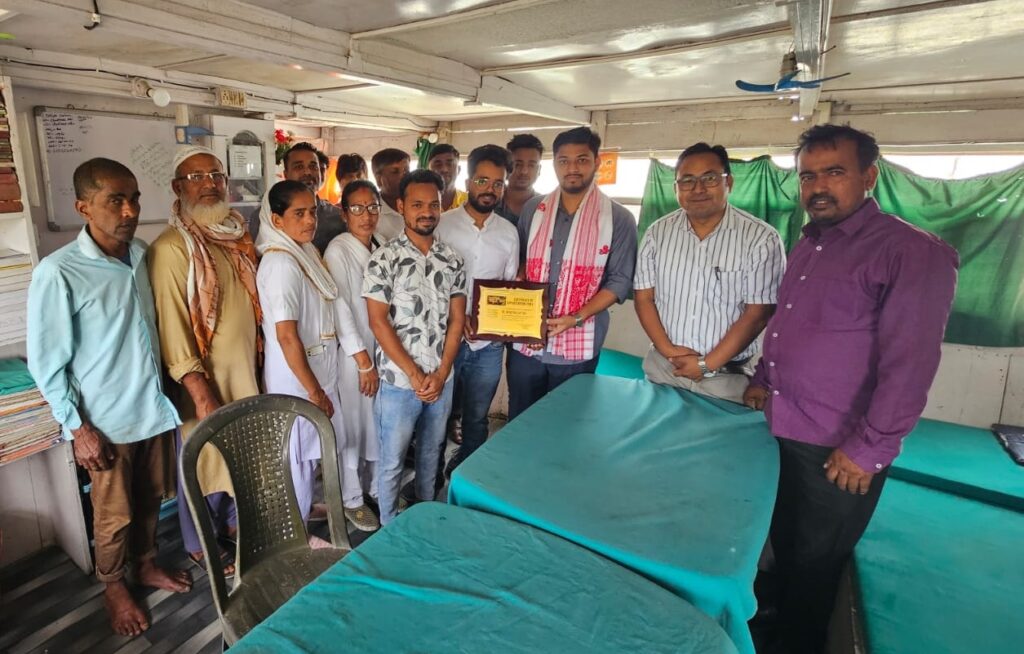 The Bongaigaon Boat Clinic bid adieu to Dr. Deepranjan Das on April 5, 2024. Dr. Das, one of the longest-serving doctors of the Boat Clinic units, has been dedicatedly serving the Bongaigaon Boat Clinic since 2015. Throughout his tenure, he was deeply involved with the community, providing essential healthcare services and building strong relationships. In recognition of his invaluable contributions, district health officials, including the District Programme Manager, Accounts Manager, and Community Mobiliser, attended the farewell function onboard the clinic. Their presence was a token of appreciation for Dr. Das’s unwavering commitment and service to the community.
The Bongaigaon Boat Clinic bid adieu to Dr. Deepranjan Das on April 5, 2024. Dr. Das, one of the longest-serving doctors of the Boat Clinic units, has been dedicatedly serving the Bongaigaon Boat Clinic since 2015. Throughout his tenure, he was deeply involved with the community, providing essential healthcare services and building strong relationships. In recognition of his invaluable contributions, district health officials, including the District Programme Manager, Accounts Manager, and Community Mobiliser, attended the farewell function onboard the clinic. Their presence was a token of appreciation for Dr. Das’s unwavering commitment and service to the community.
e-SAATHI Project Launched in Boat Clinic serviced district
The e-SAATHI project, a three-year app-based coalition initiative supported by C-NES, Population Council Consulting (PCC), Nivi India, Sitaram Bhartia Institute of Science and Research (SBISR), and The Federation of Obstetric and Gynecological Societies of India (FOGSI), has been launched to reduce maternal and early neonatal mortality rates in Assam. The project commenced in April 2023 with implementation starting in private hospitals in Kamrup Metro.
On April 9, the e-SAATHI team, along with Dr. Jitendar Nagpal from SBISR and Dr. Sowmya Ramesh, Ashita Munjral, and Namrata Goswami from PCC, visited the Kamrup Boat Clinic to officially launch the project at the island village of Nayapara, where a regular boat clinic health camp was taking place. The orientation program was initiated by Hinna Barman, Assistant Program Manager at C-NES, who introduced both teams. Namrata Goswami, State Program Manager at PCC, explained the e-SAATHI project to the participants, which included beneficiaries, ASHA workers, and Boat Clinic staff.
The team conducted an awareness session with pregnant women present at the health camp and provided a demonstration of the e-SAATHI chat app. The project aims to enhance healthcare services and improve maternal and neonatal health outcomes in the region through this innovative digital approach.
Meghalaya Officials Visit District Hospitals to observe Programme Implementation
 Kamrup, June 6, 2024 – A seven-member team of State Government Officials from Meghalaya visited the Marwari Maternity Hospital and Tola Ram Bafna Civil Hospital in Kamrup District to observe the implementation of the e-SAATHI program and understand how this digital platform is enhancing maternal health services for pregnant women.
Kamrup, June 6, 2024 – A seven-member team of State Government Officials from Meghalaya visited the Marwari Maternity Hospital and Tola Ram Bafna Civil Hospital in Kamrup District to observe the implementation of the e-SAATHI program and understand how this digital platform is enhancing maternal health services for pregnant women.
The team included Ronald Kynta, Chief Operating Officer for Meghalaya Early Childhood Development Mission (MECDM), Dr. Mary from the National Health Mission (NHM), and Bansara Nengnong, Assistant Director of the Social Welfare Department, among others.
Representatives from various supporting organizations were present, including Dr. S.K. Shikdar, Consultant & Advisor, Dr. Sowmya Ramesh, Executive Director, and Namrata Goswami, State Program Manager from Population Council Consulting (PCC), along with Patricia Dohtdong. Dr. Jitendar Nagpal and Swapnil Rawat from Sitaram Bhartia Institute of Science and Research (SBISR) also attended. The team from C-NES included Ashok O. Rao, Program Manager, Himashri Saikia, Program Coordinator, Satyam Kr Sarma, District Program Manager (DPM) of Kamrup, Shiv Richard Bordoloi, Field Executive, and Aditi Saikia, Field Executive.
During the visit, maternal health providers Anima Kalita and Mandira Sarma from Marwari Maternity Hospital onboarded three pregnant women, demonstrating the effectiveness of the e-SAATHI platform. The visiting officials observed the process and appreciated the initiative. They also interacted with the beneficiaries to gain firsthand insights into their experiences with the program.
Additionally, the Meghalaya team engaged in discussions with Dr. Sudha Agarwal, other gynecologists, doctors, and nurses to understand their perspectives and experiences with the e-SAATHI program. The visit highlighted the positive impact of the digital platform on improving maternal health services in the region.
Fulbright-Nehru Scholar Visits Boat Clinic
In recent months, Fulbright-Nehru Scholar Evan Tim from the USA visited the Boat Clinic Units in Kamrup and Majuli. Evan is set to begin his Doctorate Studies in Environmental Anthropology at the University of Pennsylvania in the Fall of 2024. Here is his account:
We arrived at the SB Nahor around dusk on 6th April 2024, the gray sky darkened with rolling thunderclouds. Flashes of lightning lit the darkness, and I wondered whether we’d face a storm. The Majuli Boat Clinic team brought boxes of supplies to the boat by lugging them across a thin gangplank, precariously set against the crumbling sanbank. This I would have to get used to: the Brahmaputra’s banks are always shifting, an environment of endless change.
I had first come across the Boat Clinic project during my reading about the broader water scenario across the Brahmaputra and Ganges river basins. As a Fulbright Scholar in India, I was studying the impacts of climate change on waterways and, in turn, the communities that live alongside them. In particular, I was interested in learning about how people thought of the future, and whether there were local, adaptive measures taking place. The boat clinic project spoke to my interests as a public initiative that seemed well-suited to the flooded contexts I was working in, often referenced as a positive example throughout literature on riverine and coastal communities.
My time traveling with the project began with a stroke of good luck. Following up on an introduction to Sanjoy Hazarika, I met with the boat clinic team in the Guwahati area for the first time in December. Bhaswati Goswami and Ashok Rao welcomed me to the office and soon mentioned that they were heading out to a clinic site the following morning. I jumped at the opportunity to join and see firsthand the work the project was doing. I imagined we would be traveling by boat, of course. Instead, I learned that the water levels had decreased so much during the past few dry seasons that it would be easier to traverse the river by jeep.
The next morning, we drove to a health camp an hour or so from Guwahati, on a nearby river island. I had never taken a car through a moving river before, and nervously clung to my seat as we forded the low-lying surface, imagining we’d be swept away. Outside the windows, young men on motorcycles skillfully undertook the same journey. Once leaving the river, we rolled over what seemed like a lunar landscape covered with glistening white dust. I had never seen anything like it. This was my first real visit to the Brahmaputra, and it was completely unlike the Hooghly River, where I had pursued most of my project. The Hooghly’s banks are set almost literally in stone, with stable ghats and concrete walls that have kept the river more or less in the same shape for centuries. This seemed less like a river and more like a flood at war with a drought, each claiming their own adjacent territory and constantly changing places.
We soon arrived at the first health camp I’d see with the project. The team, including Ashok, Bhaswati, several medical staff and a group of CSR professionals observing the project for a proposal, setup shop in a concrete schoolhouse. Bright green fields rolled away to either side. Dozens of people quickly appeared, and the clinic began with an educational component on clean water and other health issues. The role of education in medical service became clear, as the team worked to ensure awareness alongside delivering healthcare.
As a semi-fluent Bangla speaker, I chatted with several of the community members while they waited to see the medical staff. With Bhaswati and Ashok’s help in Assamese, I was able to converse about the climate issues facing the community. I learned that crops had failed in the past year due to unseasonal rainfall that damaged a chili harvest, followed by economic challenges with the falling price of corn. One of the landowners said that farming had become less profitable with the uncertain weather. He then pointed out a low-lying hill near the schoolhouse. It had been built as a flood shelter, where locals could climb out of the way of rising waters.
The impacts of climate change and the community’s proactive efforts to manage them had already become clear during this first visit. However, I also wanted to see how communities in more far-flung areas, only accessible by boat, were experiencing these changes. I also wanted to see firsthand how the boat clinic typically operated. The team was kind enough to invite me to join the Majuli District’s clinic and stay overnight on the SB Nahor later in the spring.
After arriving at the boat in March, I settled into a cabin with Dr. Abhinav Changkakoti, a recent medical school graduate and intern working with the program. I asked him about his experiences with the camps as we unpacked, and he showed me how to unroll and effectively hang a mosquito net. Despite having lived across South Asia for almost two years previously, I’d never quite gotten the hang of it. “I’ll be fine if it doesn’t cover me,” I said, trying to appear worldly and used to the challenges of river life. “You will be eaten alive,” he said grimly. He was right: and not just by mosquitos but also the long brown cockroaches and darting lizards that sang me to sleep. The boat echoed with footfalls and the sound of the team talking to their family members before going to bed. “This is a second home for us,” Riturekha said at one point in the evening. I learned that the team spent weeks every month living aboard the SB Nahor, and the boat was as familiar to them as my own apartment back in Kolkata. I felt a mix of deep appreciation for being allowed to join and a sense of wonder at this lifestyle, living on a roving medical boat that spends every night at a different island. The flexibility of this way of life seemed to echo what I knew of the Brahmaputra so far, a shifting landscape where change demanded fluidity and adjustment.
I woke up to the sound of engines running. We were already underway, the repurposed truck engine that functions as the heart of the SB Nahor chuffing along. When I poked my head above the deck, I saw an awe-inspiring and alien world. Vast, flat islands peppered with sparse grass unrolled out to the far horizon. The early morning river was a muddy gray, the sky an off-blue. Everything seemed shaded by a slight tint of slate, colored, I knew, by the rich silt that pours off of the Himalayas each year. It seemed almost empty at times, but small glimpses of people hinted at the populations that live further behind the banks, in the relative stability of the inner islands: a man standing by the water washing an array of silver pots and pans, a woman walking near a herd of cattle. A motorcycle kicked up dust near the bushes. I watched it all with intense fascination, sitting in a plastic chair on the SB Nahor’s corrugated metal upper deck.
I had no idea how long we’d been underway, but shortly after breakfast we stopped at the first camp, on Bekheli island. It was a long stretch of riverbank covered in grass, with a few motorcycle trails leading into the trees. Near the edge of the bank–which was tall, perhaps two or three meters above the water–a small group of men was building a boat. It looked enormous, perhaps as big as the SB Nahor, with long rough-cut planks stretching out under the sun. I was too shy to try my Bangla and the few words of Assamese I’d hurriedly studied before the trip to approach immediately, and just watched from a distance. Riturekha soon noticed my interest, however, and helped introduce me to one of the men, an older gentleman wearing a wide-brimmed hat who seemed to be in charge. I asked him about how the landscape had changed, and how it might look in the future. Gesturing to the broad, flat expanse, he said there used to be houses all the way down to the river’s edge. Because of erosion, the land for agriculture and housing had diminished. The area we stood on would be gone within a year, he said. I asked what would happen in ten years, with Riturekha helping clarify my Bangla into Assamese, and he replied that Bhekeli island would likely no longer exist.
Shortly after this conversation, our team boarded a tractor and cart and made our way inland. I saw fields full of water buffalo, fat pigs and scrawny chickens. The sun turned the winter grasses into a gleaming gold, and it seemed like a land of riches and plenty, in contrast to the stark vision of disappearance I had just heard. We soon stopped outside of a small village, a collection of a dozen or so houses on stilts made primarily of bamboo. The team set up their first health camp at a concrete schoolhouse, carrying boxes of medicines and speaking with a woman wearing a blue and white sari which I would later learn marked her as an accredited social health activist (ASHA). Soon, the first few patients began to arrive.
I moved between the inside of the schoolhouse and the porch, watching and taking notes as the nurses, team and Dr. Changkakoti served the patients. They collected phone numbers and names, keeping track of the patient’s data across notebooks and a mobile app. A few mothers with their children arrived, and a number of older men as well. The nurses and Dr. Changkakoti provided medicines, vaccine shots, tests and advice to the patients one at a time, while other community members chatted with the staff outside. The lime green schoolhouse was busy, especially with young women and their children. After observing for a while, I took a walk through the village and studied the houses. Built on concrete stilts with woven bamboo walls, they seemed especially designed to survive floods. Riturekha later told me that they were a hallmark of the Mising community, an indigenous group living in the area. The buildings seemed perfectly designed for a landscape of uncertainty, but I wondered how the houses would continue standing if the very ground beneath them was washed away.
After a bumpy tractor ride back to the SB Nahor, the team setup for the second health camp, this time beneath a large blue awning next to the boatbuilding site. Even more community members showed up this time, some walking over the fields and others arriving on motorbikes that seemed to slip haphazardly through the loose silt. Dr. Changkakoti administered vaccine shots and most of the patients who weren’t being treated hung around and chatted with the team. It struck me how familiar the team was with the community, seeming like old friends. Trust and relationship-building seemed an integral part of their work. Dr. Changkakoti explained more about this a few days later, as we walked by the riverbank and crickets sang out of the soupy evening. “There was a lot of misinformation before, people had to learn to have faith in doctors and medicine.” The process was ongoing, he said, with continued challenges in educating the community.
After visiting Bhekeli one and two, we reached Majuli. At our first camp on the island, I saw firsthand the remarkable speed of erosion. From below deck, I kept hearing splashing sounds. I wondered whether people were jumping into the river. Instead, huge chunks of the sandy bank were falling into the water every few minutes. Within an hour of our arrival, the bank seemed to have receded half a meter away from where we’d tied to SB Nahor. I stood and watched the island vanishing, and the predictions I’d heard so far of eventual disappearance seemed, if anything, too conservative. I had a hard time imagining Majuli island would exist by the end of the afternoon, let alone after a decade.
I chatted with a few community members using a mix of Bangla and Riturekha’s kind assistance translating in Assamese. One man described a recent initiative to slow erosion using a “porcupine” system, or a sort of underground bamboo lattice. His opinion was that these efforts were insufficient, and a concrete-based structure would be needed. I asked him the same questions I’d put to other community members–what he thought would happen in the coming years to the island and the people who lived here, how the landscape had changed during his lifetime. He said it depended on the efforts that would be made to prevent erosion, namely through the concrete intervention he mentioned, but that Majuli was undeniably shrinking. Another man spoke of how the part of the river just in front of us used to be a piece of land with homes and cultivation, and now water was only left. He mentioned how Majuli island’s rich cultural heritage was at risk of disappearing as erosion threatened livelihoods and space.
My sense of Majuli’s scale was informed only by what I had read beforehand. As the world’s largest river island, I expected it to be enormous. But as Riturekha brought me inland, I realized just how vast the landscape was. Miles of dense forest, houses, roads and shops passed as we rode in a jeep away from the riverbank. At one point, we reached a spot where a bridge had collapsed due to erosion and storms, leaving a ferry as the only crossing option. We sat on a small raft tied over two riverboats, complete with motorcycles and entire families, while a man pulled us across the swift-moving current on a rope. Upstream, the twisted metal wreckage of the bridge interrupted the flat water. I felt certain that if I fell in the water I’d never come out again. It was a stark example of the challenges in living along the Brahmaputra.
After being picked up on the other side, we made our way through a much busier part of the island. Shops and concrete buildings lined a paved road, and we visited the office of the National Health Mission for Majuli District. The staff inside were welcoming and interested in discussing the impact of climate change in the area. One team member mentioned that heatstroke was on the rise, with more individuals facing acute and long term illnesses related to the rising temperatures. Another spoke about the increased transmission of tropical disease, and encouraged me to write and speak publicly about these issues. “The world needs to know about the climate risks in Majuli,” he said.
The boat clinic project is clearly a success, and one that is often considered replicable in other contexts I have studied and visited. In the Sundarbans, for example, hospital ships would be an ideal response to the needs of communities living on shifting islands. However, it was also striking to realize the challenges that climate change posed to the project itself, and to the broader task of delivering healthcare services in a warmer and more uncertain world. Making enough ice to cool vaccine doses by running the generator was a frequent task on the SB Nahor. Damage to the boat’s hull from running aground on shifting sandbanks required repair. Unseasonal floods and droughts made it challenging to predict when and how certain communities could be reached. The boat clinic project is itself a project of resilience to an uncertain landscape, but it also is under threat from the same challenges it seeks to address.
I look forward to continuing to learn from the boat clinic team, and I greatly appreciate their kind welcome aboard the SB Nahor. Every member of the team was generous with their time, perspectives and effort, and I felt like a true part of the community. The SB Nahor’s staff also includes those who I was less able to speak to due to my insufficient Assamese, but the captain, cook and other workers aboard were incredibly kind to me despite our challenges speaking. It was a stunning and thought-provoking experience, and one that I will continue to consider as I pursue my projects on water change in South Asia.
Onwards to Shivaguri: Bringing Healthcare to Remote Communities


24th May 2024 – In the early hours of the morning, precisely at 4 am, the Dhemaji Boat Clinic team embarked on a mission to Shivaguri, a remote area on the Assam-Arunachal border. This region is home to the Mising and Adi tribes, who often face significant challenges in accessing medical care.
Our journey began from Silapathar and lasted five and a half hours. The route to our destination took us through dense forests teeming with wildlife. On several occasions, we had to clear our path by cutting down small trees and bamboo obstructing the way. Although we have encountered wild elephants during previous trips, this time we were fortunate enough not to.
Accompanying us was a Multi-Purpose Worker from Jonai BPHC, who served as our guide since it was our first time traveling to Shivaguri. His knowledge and expertise were invaluable in navigating the challenging terrain and ensuring we reached our destination safely. As part of our journey, we crossed the Taratama River by passenger boat, a crucial segment that enabled us to reach the isolated community.
Upon arrival, we were met with a heartwarming sight: locals braving the river to receive much-needed medical check-ups and medications. This reception underscored the importance of our mission and the impact of providing healthcare to underserved populations. Our team, equipped with essential medical supplies and a commitment to service, spent the day attending to the health needs of the Shivaguri residents.
The Boat Clinic initiative continues to be a vital lifeline for these remote communities, bringing healthcare directly to those who need it most.
Roje Daimari,
District Programme Officer,
Dhemaji Boat Clinic
Health Camp and Awareness Session Held by Barpeta Boat Clinic at Sewrapothar Char
An ongoing health camp with an awareness session on family planning and sickle cell disease (SCD) has been organized by the Barpeta Boat Clinic Unit at Sewrapothar Char. The initiative aligns with the global observance of World Sickle Cell Awareness Day, marked annually on June 19th, which serves as a crucial platform for raising awareness about SCD, a genetic blood disorder affecting millions worldwide.
The health camp, aimed at providing essential healthcare services and information to the local community, saw the successful insertion of Intrauterine Contraceptive Devices (IUCDs) by the boat clinic’s Auxiliary Nurse Midwife (ANM). Sixteen beneficiaries, including three Accredited Social Health Activists (ASHAs), received IUCDs, promoting effective family planning and reproductive health management.
In addition to family planning services, the camp featured an awareness session on sickle cell disease. The session educated participants on the symptoms, complications, and management of SCD, aiming to improve the quality of life for those affected and reduce the stigma associated with the condition.
The Barpeta Boat Clinic Unit’s efforts reflect a commitment to bringing crucial healthcare services to remote and underserved areas, ensuring that communities like Sewrapothar Char have access to the same level of care and information as more accessible regions. This initiative highlights the importance of community-based healthcare and the global effort to combat sickle cell disease.

- Health camp and routine immunization at Puronidhol Island village on April 6, 2024, organized by the Lakhimpur Boat Clinic.
Morigaon Boat Clinic Conducts Health Camp and Awareness Session
15th May 2024 — The Morigaon Boat Clinic is en route to conduct a health camp at the remote Inchir Char after a long walk. The clinic will also hold an awareness session on dengue and vector-borne diseases at Chutiya Gaon island village in Morigaon on 16th May 2024. The initiatives aim to provide essential healthcare services and educate the community on preventing and managing vector-borne illnesses.
Documentary Shoot Highlights Challenges and Triumphs of Kamrup Boat Clinic
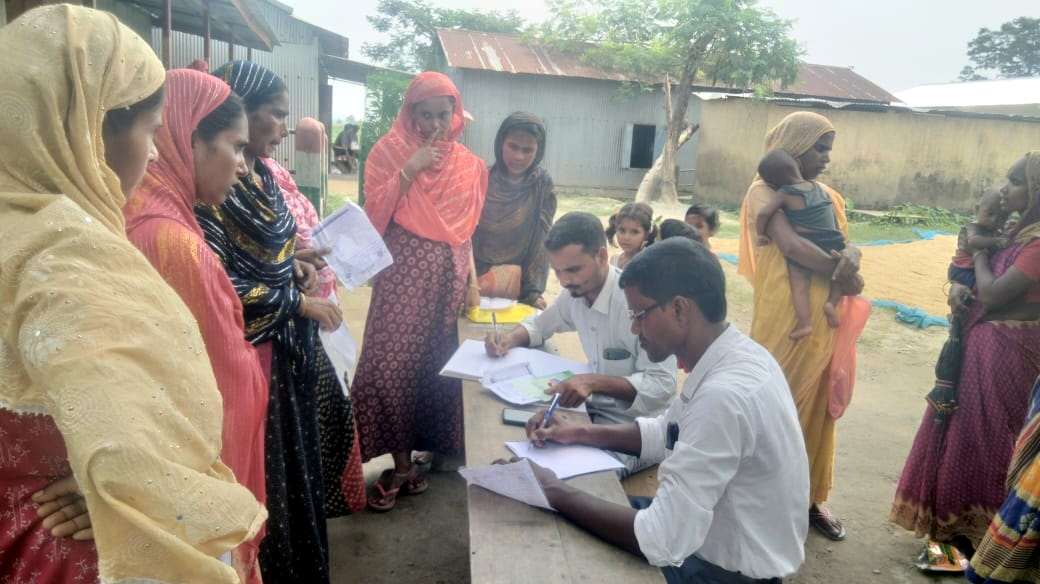

12th June 2024 — Early morning, a team from Blockchain For Impact (BFI), accompanied by Hinna Barman, Assistant Programme Manager, C-NES, embarked on a journey to the Kamrup Boat Clinic at Chaygaon, Rural Kamrup to document the challenges and successes of providing primary healthcare services to remote river island villages.
The documentary, a collaborative effort between BFI and C-NES, aims to shed light on the crucial role played by the Kamrup Boat Clinic in delivering healthcare to isolated communities. Faraj Farooqui, Strategy and Programme Manager, and Priyal Mudgal, Scientific Communication Executive at BFI, conducted interviews with key functionaries of the block healthcare machinery, including the Block Programme Manager (BPM) and Block Community Mobilizer (BCM) at Chaygaon Block Primary Health Care Centre (BPHC).
During the interviews, the block level health officials praised the Boat Clinic for its significant impact on local healthcare. They highlighted how the Boat Clinic’s intervention has greatly improved the timeliness and accessibility of immunizations for newborns and other vulnerable populatios. Before the Boat Clinic’s involvement, timely immunization was a significant challenge for the Accredited Social Health Activists (ASHAs) working in the region. With the Boat Clinic’s support, routine vaccinations have become more accessible, ensuring better health outcomes for the community.
In addition to immunization, the Boat Clinic’s efforts have been instrumental in promoting routine check-ups for pregnant women and encouraging institutional deliveries. The health camps organized by the Boat Clinic are meticulously planned and communicated to the block PHC, ensuring coordination and efficiency in addressing community health needs.
Blockchain For Impact (BFI), a global catalyst funder in the blockchain industry, aims to leverage blockchain technology to address healthcare inequalities in India. By supporting initiatives like the Kamrup Boat Clinic, BFI is contributing to innovations that bridge gaps in healthcare delivery, ultimately improving access and quality of care for underserved populations.
This documentary will not only showcase the challenges faced by the Boat Clinic team but also celebrate their dedication and the transformative impact of their work. Stay tuned for the release of this insightful documentary, which promises to highlight the intersection of healthcare and technology in addressing some of the most pressing health challenges in remote areas.






